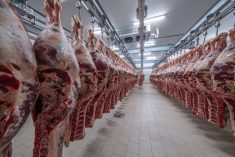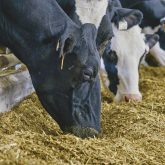A quarantined southeastern Ontario farm where 31 sheep vanished last month, just before they were to be destroyed and tested for scrapie, is now down by nine more sheep, all scrapie-negative.
The Canadian Food Inspection Agency confirmed this week that it took nine sheep from Linda Montana Jones’ farm last weekend, and that the nine sheep were destroyed and tested negative for the brain-wasting disease.
The nine were slaughtered after a sheep that recently died on the same farm and came from the same genetic cohort was tested in late April and found to be a "very strong positive," CFIA officials said.
Read Also

Ample supplies and improved livestock sector to boost Canadian feed sector: FCC
Abundant feed grain supplies and improved profitability for the livestock sector should support strong feed demand and sales through the winter, says a new report from Farm Credit Canada.
The Jones farm at Hastings, Ont., about 35 km east of Peterborough, has been under quarantine since January 2010, after a single sheep she sold to an Alberta farm in 2007 died and tested positive for scrapie.
The 31 animals that disappeared just before they were to be destroyed April 2 were a group sorted from Jones’ flock as having a genetic susceptibility to the disease, said Penny Greenwood, national manager for disease control and animal welfare with the CFIA in Ottawa.
Greenwood also confirmed that one of the nine animals destroyed this week was the dam of the scrapie-positive animal.
Jones — who with help from the Calgary-based Canadian Constitution Foundation has waged a very public fight to prevent her animals from being destroyed and tested — said in a release Thursday that the dam was 13 years old and was due to have more lambs next week.
Citing CFIA, Jones said scrapie is most often passed on in birthing fluids — but the dam of the "alleged positive" was "healthy and robust, and tested negative," she said.
Horizontal transmission
Scrapie is a federally reportable livestock ailment from the transmissible spongiform encephalopathy (TSE) family of neurodegenerative diseases, such as BSE in cattle and Creutzfeldt-Jakob disease in people.
Always fatal in infected animals, scrapie has a long incubation period and there is no known 100-per-cent-effective live test. Infected animals can spread the disease in flocks and herds without showing signs of illness.
According to Greenwood, the normal prevalence of scrapie on an infected farm ranges from three to 30 per cent.
Furthermore, she said, if one scrapie-positive ewe has a genetically susceptible lamb, a large amount of prions — the misfolded proteins that cause TSEs — is excreted at birth.
Thus, if a group of ewes are lambing in the same space, there’s nothing stopping "horizontal" transmission of scrapie to another sheep that comes in contact with infected material in the birthing environment, Greenwood said in an interview Friday.
For her part, Jones said in Thursday’s release, she has asked CFIA for DNA from the positive animal, and for tissue samples from its obex — a region of the brain stem in which scrapie is confirmed.
With those, Jones said, "a third party lab can re-test to determine if there was an ‘error’ in their alleged positive, as all other findings still indicate there is no scrapie in my flock… or what’s left of them."
"No doubt"
CFIA, which operates the only reference lab in Canada for scrapie, could supply slides and test results for confirmation by another reference lab in the U.S., but such a test would be pointless in this case as CFIA has "no doubt" that the animal in question was scrapie-positive, Greenwood said.
The target area of the sheep’s brain is "very small," Greenwood added, making it possible that one slice of sample could turn up nothing while another shows the presence of scrapie.
As for DNA samples — which Jones wants to prove whether the tested material came from her sheep — the agency will not simply hand over samples from its investigation with no chain of custody to certify the samples’ use in tests by whichever third-party lab a producer chooses.
The Ontario Provincial Police are still investigating the disappearance of the 31 sheep, Greenwood said Friday. Jones has previously said the sheep vanished sometime overnight before April 2, with only a note left behind from an unknown party called the "Farmers Peace Corp" claiming responsibility.
Given that the missing sheep were about to lamb, and especially now that a scrapie-positive sheep was found on Jones’ farm, the missing animals are considered at "high risk" of contaminating another property, Greenwood said.
The U.S. border has been shut to breeding sheep and goats from Canada since the beginning of the BSE crisis in 2003, Greenwood noted. Any re-opening of that border would hinge on the continued credibility of Canada’s scrapie eradication program, she said, and the missing sheep don’t help matters.
Editor’s Note: Any and all comments previously posted to this article have been deleted. No further comments will be accepted on this article.
















